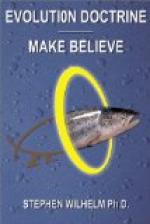We have now learned that evolution means a common ancestry of living forms that have come to differ in the course of time; our common reason has shown us also that organisms are in a true sense complicated chemical mechanisms adapted to meet the conditions under which they must operate. We come now to the evidences offered by the organic world that evolution is true and that natural forces control its workings. Clearly the examination of the matter of fact is independent of the question of method. For just as the chemist may experiment with various substances to see if they will dissolve in water and not in alcohol before it is necessary or desirable for him to take up the further studies of the laws of solution, so reasonable grounds must be found for regarding evolution as true before passing to its method of accomplishment. And in the following discussions, the animals will be used almost exclusively, not because the study of plants fails to discover the same relations and principles, but because the better known animal series is more varied and extensive, and above all for the reason that the human organism arrays itself as the highest term of the animal series.
In the complete scheme adopted by most naturalists, five categories include the evidences bearing upon the fact of evolution. These are Classification; Comparative Anatomy, or Morphology; Comparative Development, or Embryology; Palaeontology_, which comprises the facts provided by fossil relics of animals and plants of earlier geological ages; and Geographical Distribution. Each of these divisions includes a descriptive and analytical series of facts, whose characteristics are “explained” or summarized in the form of the general principles of the respective divisions. Such principles, taken singly and collectively, constitute the evidences of evolution.
The particular nature of any one of these categories, evolved in the development of science practically in the order stated, depends upon the special quality of an animal which it selects for comparison and organization in connection with other similar facts, and also in its own mode of viewing its facts. One and the same organism may present materials for two, three, or even all five of these divisions, for they are by no means mutually exclusive. For example, a common cat possesses certain definite characteristics which give it a particular place when animals more or less like it are grouped or classified according to their degrees of resemblance and difference, in small genera of very similar forms, in larger tribes or orders of similar genera, and in more and more inclusive groups of these lesser divisions, such as the classes and phyla, or main branches of the animal tree. The common cat and its relatives are even earlier to be regarded as anatomical subjects, and their thorough analysis belongs to comparative anatomy,—a name which explains itself.




